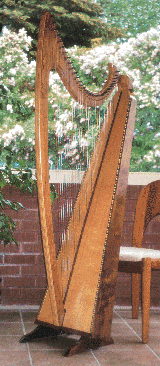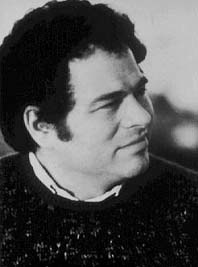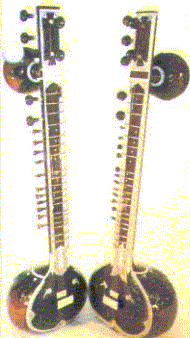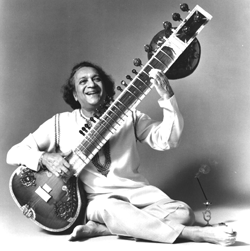| Plucked | Hammered | Bowed |
|---|---|---|
| Guitar | Clavichord | Violin |
| Harp | Piano | Viola |
| Harpsichord | Organ | Cello |
| Lute | Celeste (minature piano) |
Double Bass |
Back to: Top | Harp | Violin | Sitar
The Harp:

What is a Harp?
The Harp originated in Mesopotamia and Egypt. It is an instrument with strings stretced vertically in an open triangular frame and played by plucking the strings with the fingers. The modern harp usually has 46 or 47 strings and seven foot pedals that permit the playing of halftones.
Although the Harp has been around for centuries, it has been part of the orchestra for only about 150 years. The harp stands sixty-eight inches tall in a triangular from. It's strings differ in length and in thickness and provide a total range of six and one-half octaves. The foot pedals can alter the pitch of the strings.
The modern triangular harp first appeared in Europe in the twelfth century, although that version had no pedals. It has been basically unchanged for a thousand years, unlike other early plucked instruments, such as the guitar and the lute. Also, from the hammerered instruments, such as the clavichord and the piano. In today's symphony orchestra, it is used mostly as a solo instrument, less frequently for accompaniment.
The most familiar special effect of the harp is the glissando, the rippling sound caused by sliding fingers rapidly over the strings. Some experts call it one of the most overworked platitudes of music, but acknowledge it is nonetheless effective.
 |
| Elisabeth Chardonnet |
Elisabeth Chardonnet is a well-known harpist of our day. She was born in France and began studying the harp at age 9.
She has studied with Françoise Netter at the National School of Music of Le Mans, Pierre Jamet, Marie-Claire Jamet, at the Moscow Conservatory with Vera Dulova, and in the United States to with Susann McDonald at the Indiana University School of Music.
Over the years she has won numerous awards, such as the Performer Diploma in 1996 and the prestigious Artist Diploma in 1997, and she was a Prize winner at the 1998 U.S.A. International Harp Contest. Her first solo CD is Angélus. She is planning Duo Millenia's 2000-01 concert season.
For more information on the HARP Click Here.
Back to: Top | Harp | Violin | Sitar
The Violin:

What is a Violin?
The violin was developed in the 17th century but became popular around 1700. It is played with a bow, is characterized by four strings tuned in fifths, and have fretless fingerboards. The violin is the highest pitched of the String family, yet it is the smallest. But, is the orchestra's most important member, and is its primary source of melody.
The violin's strings are made of pig gut, sheep gut, steel or nylon -- generally steel or nylon today. The strings are of different thickness; the sound comes from their vibration as they are stroked with a horsehair stretched along a wooden bow. To achieve a given note, the musician presses a finger against a string, changing the effective length A short string produces a higher note than a longer one. No instrument is more flexible; the violinist can produce a greater variety of sounds than any other musician in the orchestra.
 Click icon to hear the VIOLIN.
Click icon to hear the VIOLIN.
 Click icon to view VIOLIN video.
Click icon to view VIOLIN video.
 |
| Itzhak Perlman |
One of the greatest violinists of our era, Itzhak Perlman was born in Tel Aviv, Israel in 1945. he took to the violin at an early age, receiving his first lessons at the Music Academy of Tel Aviv.
At the age of thirteen, he came to the United States to participate in Ed Sullivan's Caravan of Stars, a traveling musical showcase for gifted children. From there he attended the prestigious Julliard School of Music.
For three decades, Itzhak Perlman has enjoyed a peerless career as the best-known - and most in-demand - violinist on the cconcert stage. He has recorded virtually every major work for the violin. He has played from chamber music to Jazz and everything in between.
Perlman has transcended the traditional bounds of musicianship; performer, speaker, teacher, collaborator and friend to countless young musicians, he is an invaluable ambassador for the human spirit.
For more information on the VIOLIN Click Here.
Back to: Top | Harp | Violin | Sitar
The Sitar:
What is a Sitar?
The sitar is a classical instrument of Northern India which has 18 strings, 20 frets and an amazing sound.
Sitar music is composed according to various ragas. The closest western comparisons are blues scales and riffs. Ragas are rhythmic sequences, and notal combinations, which have been passed on through verbal tradition.
Pictured here are two sitars standing upon their gourd bases.

One of the most versatile instruments in the world, the sitar allows a musician a wide range of expression. Micro-tonal variation is very easy to create The frets (the numerous bar like objects that cross the fingerboard (main part) of the sitar) are posable and are tied onto the instrument. Different ragas emphasize different positions, and the artist often sets the frets a little off normal to provide the micro-tonal combination that he desires.
Unlike guitar frets, sitar frets are very curved and raised above the fingerboard and some strings actually run under them, and thus can not be fretted. When a string is fretted the tone or note it produces will change. The curved frets allow more versatility in bending a note than on a guitar. The sitar is played with a wire metal pick called a mizrab which allows the musician to play every level of strings at the same time.
 |
| Pandit Ravishankar |
Among the contemporary sitar artistes, Pandit Ravishankar is a living legend. His efforts to popularise the instrument worldwide has far excelled even his own expectations.
This rare genius has opened the ears and minds of millions to the wondrous aesthetic of India's ancient musical tradition.
Ravi Shankar has been awarded an honourary knighthood by the Queen of England.
For more information on the SITAR Click Here.
Back to: Top | Harp | Violin | Sitar
Christine Williams & Mitul Sanghvi
Last Revised: January 14, 2002
All Rights Reserved
Void where prohibited
 Contact: soundsofmusic02@hotmail.com
Contact: soundsofmusic02@hotmail.com
Home Page | Brass | Percussion | Strings